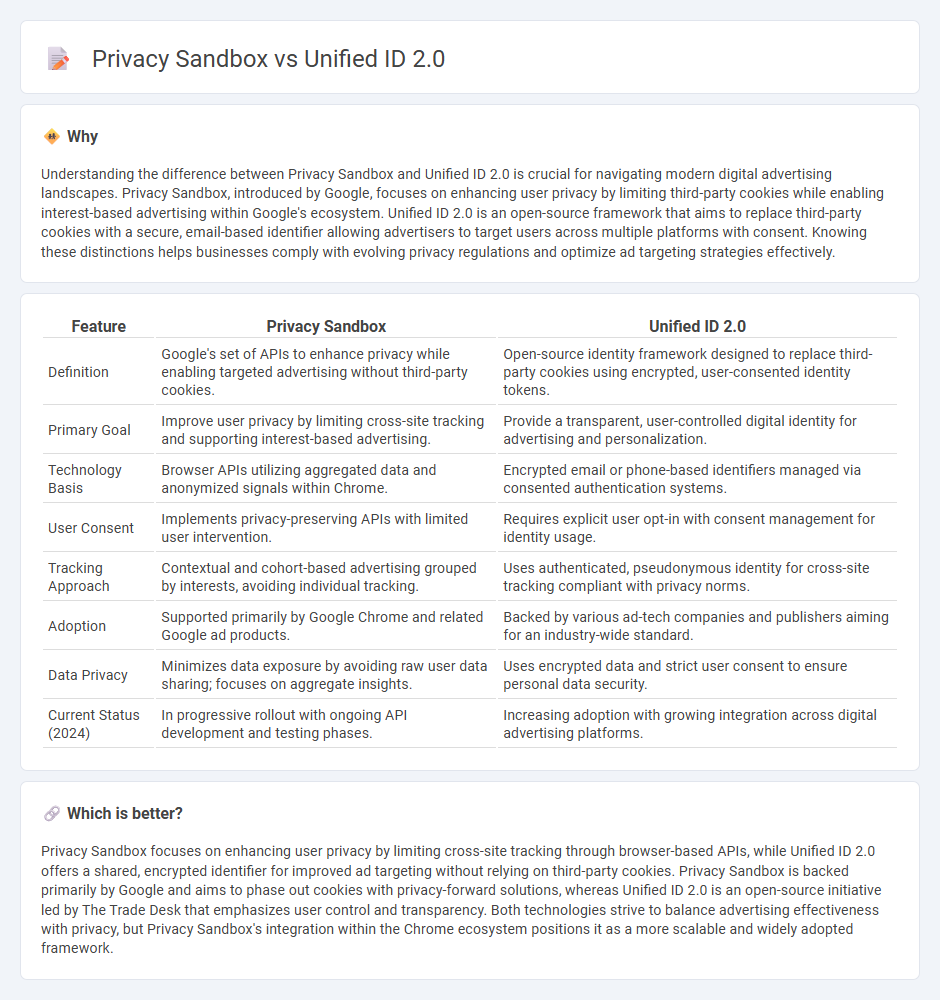
Privacy Sandbox and Unified ID 2.0 represent two innovative approaches to digital advertising that prioritize user privacy while enabling effective targeting. Privacy Sandbox, developed by Google, focuses on minimizing third-party cookies through APIs that protect user data within the browser. Explore how these technologies are reshaping the future of online privacy and advertising efficiency.
Why it is important
Understanding the difference between Privacy Sandbox and Unified ID 2.0 is crucial for navigating modern digital advertising landscapes. Privacy Sandbox, introduced by Google, focuses on enhancing user privacy by limiting third-party cookies while enabling interest-based advertising within Google's ecosystem. Unified ID 2.0 is an open-source framework that aims to replace third-party cookies with a secure, email-based identifier allowing advertisers to target users across multiple platforms with consent. Knowing these distinctions helps businesses comply with evolving privacy regulations and optimize ad targeting strategies effectively.
Comparison Table
| Feature | Privacy Sandbox | Unified ID 2.0 |
|---|---|---|
| Definition | Google's set of APIs to enhance privacy while enabling targeted advertising without third-party cookies. | Open-source identity framework designed to replace third-party cookies using encrypted, user-consented identity tokens. |
| Primary Goal | Improve user privacy by limiting cross-site tracking and supporting interest-based advertising. | Provide a transparent, user-controlled digital identity for advertising and personalization. |
| Technology Basis | Browser APIs utilizing aggregated data and anonymized signals within Chrome. | Encrypted email or phone-based identifiers managed via consented authentication systems. |
| User Consent | Implements privacy-preserving APIs with limited user intervention. | Requires explicit user opt-in with consent management for identity usage. |
| Tracking Approach | Contextual and cohort-based advertising grouped by interests, avoiding individual tracking. | Uses authenticated, pseudonymous identity for cross-site tracking compliant with privacy norms. |
| Adoption | Supported primarily by Google Chrome and related Google ad products. | Backed by various ad-tech companies and publishers aiming for an industry-wide standard. |
| Data Privacy | Minimizes data exposure by avoiding raw user data sharing; focuses on aggregate insights. | Uses encrypted data and strict user consent to ensure personal data security. |
| Current Status (2024) | In progressive rollout with ongoing API development and testing phases. | Increasing adoption with growing integration across digital advertising platforms. |
Which is better?
Privacy Sandbox focuses on enhancing user privacy by limiting cross-site tracking through browser-based APIs, while Unified ID 2.0 offers a shared, encrypted identifier for improved ad targeting without relying on third-party cookies. Privacy Sandbox is backed primarily by Google and aims to phase out cookies with privacy-forward solutions, whereas Unified ID 2.0 is an open-source initiative led by The Trade Desk that emphasizes user control and transparency. Both technologies strive to balance advertising effectiveness with privacy, but Privacy Sandbox's integration within the Chrome ecosystem positions it as a more scalable and widely adopted framework.
Connection
Privacy Sandbox and Unified ID 2.0 are connected through their shared goal of enhancing user privacy while enabling targeted advertising in the digital ecosystem. Privacy Sandbox, developed by Google, focuses on replacing third-party cookies with privacy-preserving APIs, whereas Unified ID 2.0 offers an open-source identity solution leveraging encrypted user data for personalization without compromising anonymity. Both frameworks aim to balance advertisers' needs for accurate user identification with increased transparency and user consent in data sharing.
Key Terms
User Identity
Unified ID 2.0 offers a privacy-conscious approach to user identity by using encrypted email addresses and first-party data, facilitating personalized advertising while minimizing third-party tracking. In contrast, Privacy Sandbox by Google aims to replace third-party cookies with on-device processing and aggregated data sharing, enhancing user privacy but limiting granular targeting. Discover how these emerging frameworks shape the future of digital advertising and user identity management.
Privacy Controls
Unified ID 2.0 enhances user privacy by providing transparent consent management and encrypted data sharing between advertisers and publishers, ensuring compliance with evolving privacy regulations. The Privacy Sandbox, developed by Google, introduces aggregated data processing and cohort-based targeting to minimize user-level data exposure while maintaining ad relevance. Explore the detailed mechanisms of both frameworks to understand their impact on digital advertising privacy controls.
Ad Targeting
Unified ID 2.0 offers a privacy-centric solution for ad targeting by utilizing hashed email addresses and encrypted identifiers to enable precise user matching without exposing personal data. Google's Privacy Sandbox employs browser-based APIs like FLoC and Topics to group users with similar interests, aiming to deliver relevant ads while minimizing cross-site tracking. Explore how these technologies are shaping the future of ad targeting in a privacy-first ecosystem.
Source and External Links
What is Unified ID 2.0 - Benefits, Features & Relevance [2025] - Unified ID 2.0 is a new digital advertising standard that improves privacy and ad targeting by using a hashed email address token with user consent, replacing third-party cookies in real-time bidding environments.
Unified ID 2.0 Explained - UID2 is an open-source framework that creates privacy-compliant identifiers from user consented email addresses, designed to replace third-party cookies for better privacy and precise ad targeting.
What Is Unified Id 2.0? - Publift - UID2 is a privacy-focused identifier made by hashing user email or phone after explicit consent, enabling publishers to share anonymized tokens with ad tech platforms for targeted advertising.
 dowidth.com
dowidth.com